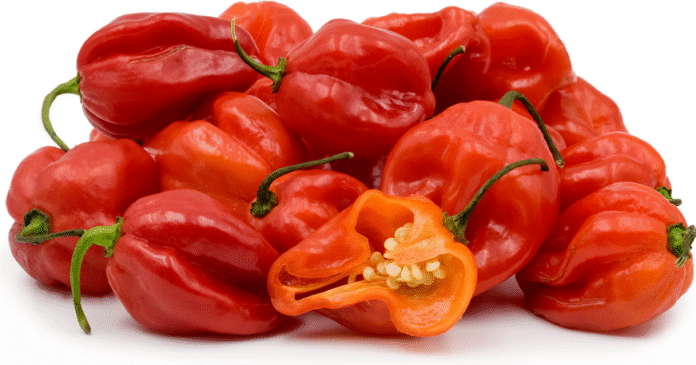The Scotch Bonnet Pepper is a fiery chili that commands respect in kitchens worldwide. With its distinctive shape resembling a Scottish tam o’ shanter hat, this pepper packs intense heat alongside a surprisingly fruity flavor. A cornerstone of Caribbean cooking, the Scotch Bonnet Pepper has gained global recognition for its ability to transform dishes with both spice and depth.
A Pepper with Caribbean Roots
Native to the tropical climates of the Caribbean, particularly Jamaica, the Scotch Bonnet Pepper (Capsicum chinense) thrives in warm, humid conditions. It shares botanical ties with the habanero but stands out with its sweeter, more complex taste. Ranging from 100,000 to 350,000 Scoville Heat Units (SHU), it sits among the world’s hottest peppers, yet its fruity undertones make it a favorite among chefs.
Visually, the Scotch Bonnet Pepper is small and bulbous, typically measuring 1.5 to 2.5 inches wide. Its skin is slightly wrinkled, and its colors shift from vibrant yellow and orange to deep red as it ripens. Some rare varieties even develop a rich chocolate-brown hue, adding a smoky dimension to its flavor.
A Culinary Powerhouse
In Caribbean cuisine, the Scotch Bonnet Pepper is indispensable. It’s the soul of jerk seasoning, infusing dishes like jerk chicken and pork with their signature fiery-sweet profile. Hot sauces, such as Trinidad’s famous “mother-in-law” sauce, rely on its intense heat, while soups and stews gain depth from its fruity punch.
Beyond the islands, this pepper has made waves in West African and Latin American cooking. Nigerian pepper soup and Ghanaian shito sauce owe their boldness to the Scotch Bonnet Pepper, while Mexican salsas occasionally feature it for an extra kick. Its versatility allows it to enhance everything from marinades to pickles, proving that heat and flavor can coexist beautifully.
Health Benefits Behind the Heat
While the Scotch Bonnet Pepper is famed for its spice, it also offers notable health benefits. Capsaicin, the compound responsible for its heat, has anti-inflammatory properties and may aid in pain relief. Studies suggest it can boost metabolism, potentially supporting weight loss efforts.
Rich in vitamins A and C, this pepper strengthens the immune system and promotes healthy skin. Its antioxidants combat oxidative stress, reducing the risk of chronic diseases. However, due to its extreme heat, moderation is key—especially for those new to spicy foods.
Growing Your Own Scotch Bonnet Peppers
For gardening enthusiasts, cultivating Scotch Bonnet Peppers can be a rewarding challenge. These plants flourish in warm, sunny environments, making them ideal for tropical or subtropical regions. In cooler climates, they can thrive in greenhouses or as potted indoor plants.
Start seeds indoors in early spring, transplanting them once temperatures consistently stay above 60°F. Well-draining soil and regular watering are essential, but avoid overwatering to prevent root rot. With proper care, the plants will bear fruit in about three to four months. Harvest when the peppers are fully colored and firm, signaling peak flavor and heat.
Handling with Care
The Scotch Bonnet Pepper demands caution in the kitchen. Always wear gloves when handling to prevent skin irritation, and avoid touching your face. If the heat becomes overwhelming, dairy products like milk or yogurt can help neutralize the burn.
When cooking, start with a small amount—even a quarter of a pepper can significantly spice up a dish. Removing seeds and membranes reduces heat slightly, but the pepper’s fruity essence remains intact. For a milder infusion, steep a whole pepper in soups or sauces and remove it before serving.
Varieties to Explore
Not all Scotch Bonnet Peppers are created equal. The classic red variety delivers a balanced heat and sweetness, while the yellow type tends to be slightly milder and fruitier. The rarer chocolate Scotch bonnet offers a smoky, earthy flavor, perfect for barbecue rubs and rich sauces.
Each variety brings a unique twist to recipes, encouraging culinary experimentation. Whether you’re crafting a traditional Caribbean dish or inventing a new fusion creation, there’s a Scotch Bonnet Pepper to match your vision.
Global Influence and Modern Uses
The Scotch Bonnet Pepper has transcended its Caribbean origins, inspiring chefs and mixologists worldwide. It’s found in spicy cocktails, gourmet chocolates, and even artisanal ice creams. In the craft beer scene, brewers use it to add a fiery kick to stouts and ales.
Its adaptability makes it a star in vegan and vegetarian cooking, where it adds depth to meatless dishes. From spicy mango salsa to coconut-infused curries, the Scotch Bonnet Pepper continues to push culinary boundaries.
Embracing the Heat
The Scotch Bonnet Pepper is more than a spice—it’s a cultural emblem with a legacy of flavor and fire. Whether you’re a seasoned heat lover or a curious foodie, this pepper invites you to explore its bold character. For more insights and recipes, visit Scotch Bonnet Pepper and discover how this tiny chili can elevate your cooking to new heights.


